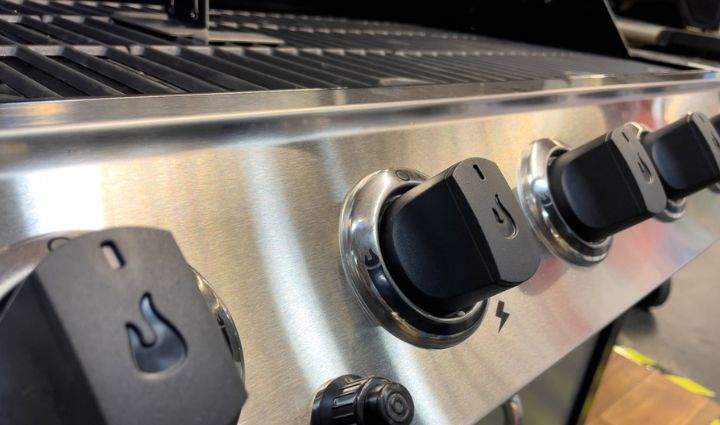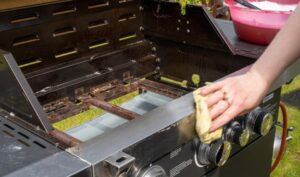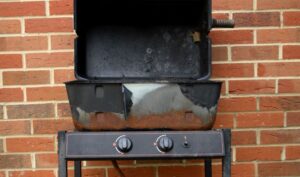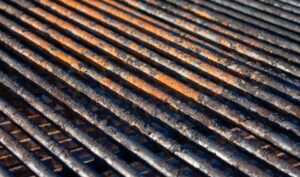The Complete Guide to Troubleshooting Gas Grill Issues is your source for step-by-step instructions on how to diagnose and fix the most common gas grill issues. Whether your grill isn’t heating properly, won’t stay lit, or simply has rusty parts, we’ve got the answers you need to get your gas barbecue firing on all cylinders.
You’ve prepped your meal and you turn on your grill, but for some reason your gas grill won’t ignite. A gas grill that won’t fire up at all is frustrating—especially when hungry people are waiting—but is typically pretty easy to fix.
There are several reasons your gas grill may not be igniting:
- Gas flow issues
- Inclement weather
- Dead battery
- Corrosion, rust, or dirt on igniter electrodes
- Loose wire
- Damaged or dead igniter
In this section of the Complete Guide to Troubleshooting Gas Grill Issues, we’ll help you figure out why your gas grill won’t ignite and how to fix it.
Let’s get you back to grilling.
6 Reasons Your Gas Grill Won’t Ignite
1. Gas flow issues
When you press or turn the igniter, does it make a clicking noise or a hard snap sound? If it does, this indicates that your igniter is indeed working, so the problem with your grill is likely related to problems with the burners or gas flow, such as:
- There is no gas in your propane tank
- Your grill is in bypass mode
- There’s a loose connection or leak
- Your burners are misaligned or clogged
Learn more about these issues and how to resolve them in the Gas Grill is Not Getting Gas section of our Troubleshooting Guide.
2. Inclement weather
If your gas grill won’t light after rain or snow, the igniter may be wet and unable to spark. In this case, gas will still be flowing and you should be able to carefully light your grill with a long match or a gas barbecue lighter. The heat from the lit grill will eventually dry out the igniter and resolve the problem.
3. Dead battery
Is your igniter battery-powered? Dead batteries are one of the most common causes of igniter issues and one of the first things you should check if your grill won’t ignite. Thankfully it’s one of the quickest fixes, assuming you have extra batteries on hand.
To replace your igniter’s battery:
- Turn the igniter button cover or spark generator battery cover counterclockwise to remove it
- Take out the old battery
- Insert a fresh one and replace the cover
- Try lighting your grill
If you notice that the old battery is corroded or the igniter still won’t spark after inserting a new one, the igniter may simply be dirty or need reconnecting.
GRILL SPOT TIP: Any time you are putting your grill into storage or are going away on vacation for longer than a week, remove the igniter batteries. This decreases the chance of corrosion and helps to extend the life of the batteries.
4. Dirty or corroded electrodes
Just like the rest of your grill, igniters are exposed to grease, dirt, food debris, and fumes. This can result in a buildup of grime on the electrodes, making it impossible for the battery to make contact with the electrodes and resulting in an igniter that can’t create a spark.
You can clean a dirty or corroded electrode with a cotton swab and a bit of rubbing alcohol. Follow these steps:
- Remove the battery and inspect it for corrosion (typically looks like a white or off-white crust)
- Brush away any dry debris
- Dip the cotton swab into some rubbing alcohol
- Gently rub the wet cotton swab over the metal tip of the electrode
- Let it dry (it should dry very quickly)
- Replace the battery
- Attempt to start the grill
You may have to swab the electrode a few times to get it totally clean. If you notice that the electrode itself is corroded—something that can happen from exposure to moisture—you can lightly sand off the corrosion.
5. Loose connection
While replacing the battery and/or cleaning the electrodes, you should also inspect the placement of the electrodes and wire connections to ensure they aren’t loose.
Electrodes are usually located in one of two places:
- The collector box near the burner, which may be mounted in the front or side of the burner box
- On the side of the burner itself.
Ensure that the gas is off, then inspect the components:
- Check that the electrodes are in good shape and that the metal tips are still intact with no cracks or breaks.
- Look for frayed wires—moisture, weather, and occasionally rodents can fray wires over time.
If the wires and the electrodes both look good, ensure all the connections are secure:
- Disconnect and reconnect the electrodes from the wires
- Disconnect and reconnect the wires from the igniter box and ignition switch (if you have a remote switch unit)
6. Damaged or dead igniter
If your igniter still won’t work after trying all of these fixes, it may need to be replaced entirely. Conveniently, both battery-powered and piezo igniters are easy to replace—it only takes a few minutes once you have the part(s).
There are two basic types of electronic battery-powered gas grill igniters:
- In remote switch units, the ignition button and spark generating unit are separate. The ignition button is mounted on the control panel with two ignition wires attached to the button that lead to the battery unit, which is typically mounted on the side panel of the grill storage cabinet.
- All-in-one ignition modules are self-contained and include both the battery unit and the ignition button. All-in-one ignition modules are mounted directly behind the control panel.
Follow these steps to replace a spark generator:
- Shut off the gas supply and make sure your control knobs are set to off.
- Locate the igniter box. Unscrew the visible front part of the igniter button, knob, or screws to loosen the collector box.
- Make note of how the wires enter the collector box, then disconnect the wires and remove the old collector box.
- Attach the wires of the new ignition kit to the appropriate ports. If your grill has an igniter for each burner, you may need to remove each control knob cover and the control panel to expose each spark generator. All you need is a screwdriver to remove the control panel.
- Screw the collector box back in place and fire up your grill.
Conclusion
If your grill won’t ignite, it can quickly throw a wrench in your cookout plans. Thankfully, there are several simple problems with easy fixes that may be causing the problem:
- Gas flow issues
- Inclement weather
- Dead batteries
- Dirty or corroded electrodes
- Loose connection
- Damaged or dead igniter
Learn more about different grill problems, what causes them, and how to solve them in our Complete Guide to Troubleshooting Gas Grill Issues:





